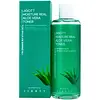What's inside
What's inside
 Key Ingredients
Key Ingredients

 Benefits
Benefits

 Concerns
Concerns

 Ingredients Side-by-side
Ingredients Side-by-side

Water
Skin ConditioningGlycerin
HumectantPropylene Glycol
HumectantAlcohol Denat.
AntimicrobialNiacinamide
Smoothing1,2-Hexanediol
Skin ConditioningMethylpropanediol
SolventSodium Hyaluronate
HumectantPolysorbate 80
EmulsifyingCarbomer
Emulsion StabilisingAloe Barbadensis Leaf Extract
EmollientCamellia Sinensis Leaf Extract
AntimicrobialChamomilla Recutita Flower Extract
MaskingCentella Asiatica Extract
CleansingHamamelis Virginiana Extract
AntiseborrhoeicRosa Centifolia Flower Extract
AstringentLactobacillus/Soybean Ferment Extract
Skin ConditioningSalix Alba Bark Extract
AstringentCinnamomum Cassia Bark Extract
MaskingChamaecyparis Obtusa Leaf Extract
Skin ConditioningOriganum Vulgare Leaf Extract
Skin ConditioningScutellaria Baicalensis Root Extract
AstringentPortulaca Oleracea Extract
Skin ConditioningAdenosine
Skin ConditioningDisodium EDTA
Parfum
MaskingWater, Glycerin, Propylene Glycol, Alcohol Denat., Niacinamide, 1,2-Hexanediol, Methylpropanediol, Sodium Hyaluronate, Polysorbate 80, Carbomer, Aloe Barbadensis Leaf Extract, Camellia Sinensis Leaf Extract, Chamomilla Recutita Flower Extract, Centella Asiatica Extract, Hamamelis Virginiana Extract, Rosa Centifolia Flower Extract, Lactobacillus/Soybean Ferment Extract, Salix Alba Bark Extract, Cinnamomum Cassia Bark Extract, Chamaecyparis Obtusa Leaf Extract, Origanum Vulgare Leaf Extract, Scutellaria Baicalensis Root Extract, Portulaca Oleracea Extract, Adenosine, Disodium EDTA, Parfum
Water
Skin ConditioningGlycerin
HumectantButylene Glycol
HumectantRice Ferment Lees
HumectantGlutamic Acid
HumectantArginine
MaskingLeucine
Skin ConditioningCeramide NP
Skin ConditioningCeramide AP
Skin ConditioningPlacental Extract
Arbutin
AntioxidantGlycyrrhetinic Acid
Skin ConditioningSoy Protein Phthalate
EmollientMaltitol
HumectantMethyl Gluceth-10
EmulsifyingPEG-60 Hydrogenated Castor Oil
EmulsifyingHydroxyethylcellulose
Emulsion StabilisingStyrene/Acrylates Copolymer
Citric Acid
BufferingSodium Citrate
BufferingPhenoxyethanol
PreservativeMethylparaben
PreservativeParfum
MaskingWater, Glycerin, Butylene Glycol, Rice Ferment Lees, Glutamic Acid, Arginine, Leucine, Ceramide NP, Ceramide AP, Placental Extract, Arbutin, Glycyrrhetinic Acid, Soy Protein Phthalate, Maltitol, Methyl Gluceth-10, PEG-60 Hydrogenated Castor Oil, Hydroxyethylcellulose, Styrene/Acrylates Copolymer, Citric Acid, Sodium Citrate, Phenoxyethanol, Methylparaben, Parfum
 Reviews
Reviews

Ingredients Explained
These ingredients are found in both products.
Ingredients higher up in an ingredient list are typically present in a larger amount.
Glycerin is already naturally found in your skin. It helps moisturize and protect your skin.
A study from 2016 found glycerin to be more effective as a humectant than AHAs and hyaluronic acid.
As a humectant, it helps the skin stay hydrated by pulling moisture to your skin. The low molecular weight of glycerin allows it to pull moisture into the deeper layers of your skin.
Hydrated skin improves your skin barrier; Your skin barrier helps protect against irritants and bacteria.
Glycerin has also been found to have antimicrobial and antiviral properties. Due to these properties, glycerin is often used in wound and burn treatments.
In cosmetics, glycerin is usually derived from plants such as soybean or palm. However, it can also be sourced from animals, such as tallow or animal fat.
This ingredient is organic, colorless, odorless, and non-toxic.
Glycerin is the name for this ingredient in American English. British English uses Glycerol/Glycerine.
Learn more about GlycerinParfum is a catch-all term for an ingredient or more that is used to give a scent to products.
Also called "fragrance", this ingredient can be a blend of hundreds of chemicals or plant oils. This means every product with "fragrance" or "parfum" in the ingredients list is a different mixture.
For instance, Habanolide is a proprietary trade name for a specific aroma chemical. When used as a fragrance ingredient in cosmetics, most aroma chemicals fall under the broad labeling category of “FRAGRANCE” or “PARFUM” according to EU and US regulations.
The term 'parfum' or 'fragrance' is not regulated in many countries. In many cases, it is up to the brand to define this term.
For instance, many brands choose to label themselves as "fragrance-free" because they are not using synthetic fragrances. However, their products may still contain ingredients such as essential oils that are considered a fragrance by INCI standards.
One example is Calendula flower extract. Calendula is an essential oil that still imparts a scent or 'fragrance'.
Depending on the blend, the ingredients in the mixture can cause allergies and sensitivities on the skin. Some ingredients that are known EU allergens include linalool and citronellol.
Parfum can also be used to mask or cover an unpleasant scent.
The bottom line is: not all fragrances/parfum/ingredients are created equally. If you are worried about fragrances, we recommend taking a closer look at an ingredient. And of course, we always recommend speaking with a professional.
Learn more about ParfumWater. It's the most common cosmetic ingredient of all. You'll usually see it at the top of ingredient lists, meaning that it makes up the largest part of the product.
So why is it so popular? Water most often acts as a solvent - this means that it helps dissolve other ingredients into the formulation.
You'll also recognize water as that liquid we all need to stay alive. If you see this, drink a glass of water. Stay hydrated!
Learn more about Water